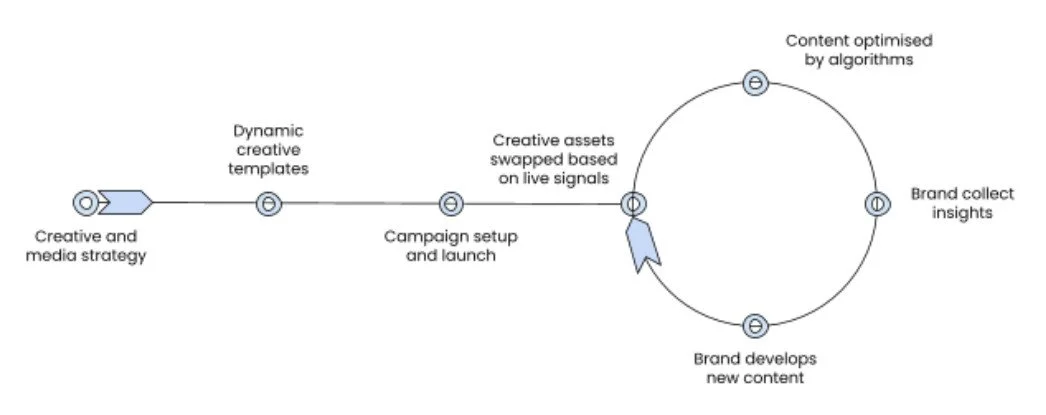Creative Intelligence in a world that prioritises privacy.
Because of an odd catalyst, third-party cookies, the marketing business is entering a new golden era of potential.
As third-party cookies become less common, industry leaders are focusing on honing their "creative intelligence" to better reach and engage customers. Creative intelligence is defined as the capacity to personalise creatives without relying on third-party data, and then deliver these advertisements to the right audiences, with the right messages, at the right times, utilising cutting-edge technologies. Without requiring any personal information, the creative feels relevant and interesting.
In this new era with fewer 'cookies', we have a few tips on how your business can create a privacy-safe strategy.
1. Find the triggers to create unique creatives
Marketers must dismiss personalised ads in favour of a new strategy. Contextual ads are ads that can be customised based on readily available information like date, time, weather, and even traffic conditions. This data has been around for years but is often overlooked. These data points can help marketers create relevant and unobtrusive creatives.
An innovative privacy-friendly video ad campaign from a Belgian windshield repair company recently drove sales. The company delivered ads based on real-time data such as weather and streaming program preferences, as well as first-party data such as car ownership status. The user's country and language preferences were also added. With all of this information, the company could serve targeted automated ads to individual viewers.
To illustrate this point, a French speaker in Brussels watching a funny sitcom would be served an upbeat advertisement in French featuring rear windshield replacement and details about the company's service centres closest to them.
The ads reduced conversion costs by 89 percent and increased bookings at a low cost per acquisition.
While third-party cookies are being phased out, marketers can adapt by using contextual signals and first-party data to segment audiences. Marketing teams can then use statistical models to refine audience clustering and forecast future behaviour. This helps teams target relevant ads to the right audiences.
2. Invest in creatives, then automate
Media buying and ad tech are often considered more important than creative. However, according to Forrester research, shifting marketing budget from technology to creative resources can increase ROI by up to 18%.
Marketers will need both creativity and automation to tap into this growth potential. With automated solutions, teams can save time and energy while delivering highly relevant ads to potential customers.
Douglas, a European beauty retailer, recently demonstrated the power of creative automation to deliver targeted ads. The company used Google's Affinity Audiences to reach a wider audience of like-minded people. In order to target their audiences, Douglas used contextual signals to deliver ads to online pages that contained specific keywords.
The company delivered these ads with automated, customised creative. Based on first-party data and the pages they visited, high-end beauty brands and products were shown to high-potential consumers. Douglas aimed to increase their average order value. Other viewers saw ads for makeup, perfume, or skin care, with lower prices. It automatically swapped creative assets and products to make ads feel more relevant to customers.
3. Make use of a test-and-learn strategy
New creative workflows are required. From a linear process to a constant feedback loop.
Begin with creative and media strategy, then gather and optimise data, then create new content. Creating dynamic ad templates allows for real-time creative element addition and combination. Then technologies like Cloud Vision API can analyse visual elements and determine what works best, like showing a person in an ad or just showing the product. With some trial and error, new creative elements can be added to the mix and used in the ad templates. It's all about automating improvements to create the best ads.
Marketers may need to focus on new metrics to measure their success as they move away from third-party cookies and toward creative processes. The importance of key performance indicators like click-through and conversion rates may change in the future. Such as engagement, brand lift, and ROI.
The marketing industry's key takeaways:
As the marketing world transitions to a new privacy-first future, the power of creative marketing and smart automation will only grow.
Here are some points to consider when rethinking your brand's creative strategy:
Pick the best signals. Choose the right signals to tell your audience a personalised story. Make new connections with your audience using data and technology.
Automate in new ways. Invest in creatives, then automate asset workflow to easily build and edit creatives.
Try and learn. Continue to refine your brand's creative elements and gather data.
If you are still unsure of how to run a successful digital marketing campaign in this privacy-first era, contact us and our team of experts can help you take your business to the next level.




